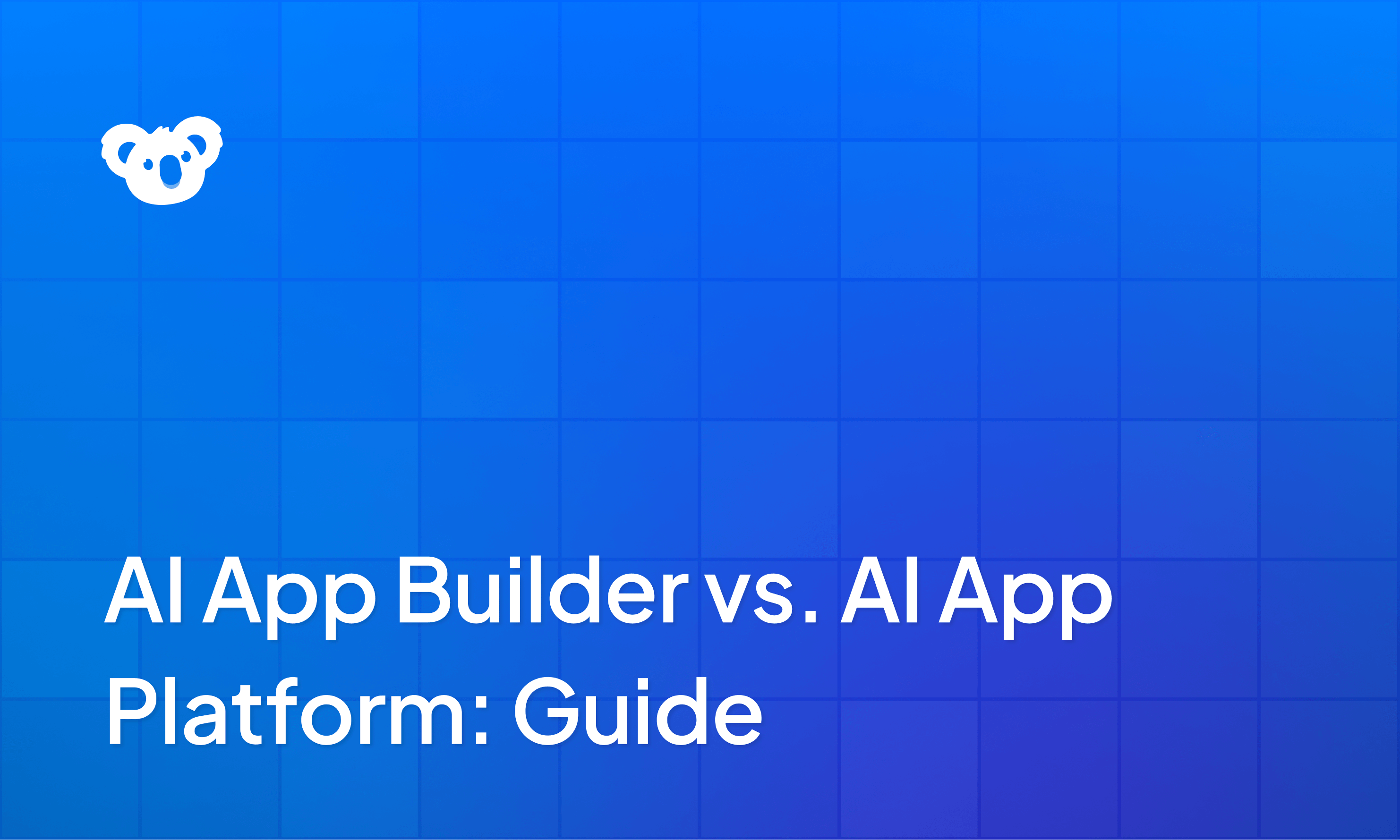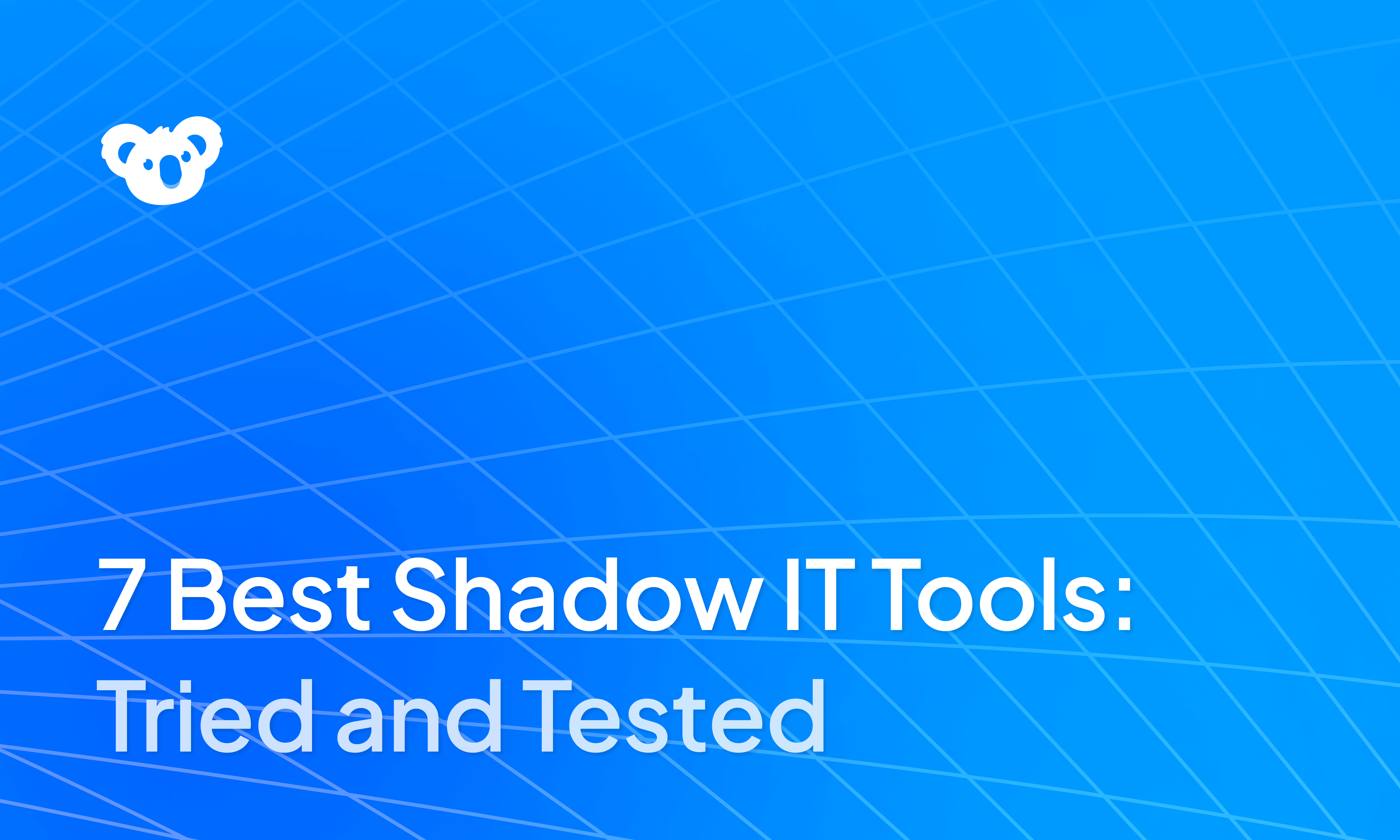


I tested over 20 AI risk management software for enterprises and shortlisted 10 that deliver real value for managing AI deployment risks.
10 best AI risk management software: TL;DR
If you’re short on time, here’s a quick overview of the 5 best AI risk management platforms plus their starting prices:
1. Superblocks

What it does: Superblocks solves the risk and overhead of building and maintaining internal apps within teams with a prompt to app AI internal app development platform.
Who it's for: CIOs, IT leaders, and semi-technical teams in operationally heavy enterprises who want to democratize tool-building while enforcing strict security.
Here's the thing about AI in the enterprise. Your teams will build with it whether you give them permission or not. The question is whether they'll do it in some random tool they found online, or in a place where you can actually see what's happening.
Superblocks addresses this risk. Teams can generate internal applications using natural language prompts, but everything stays within the guardrails you control.
Key features
- AI app builder: Instantly generates internal tools from natural language prompts, refines them visually, or uses code in your preferred IDE.
- Centralized SSO, audit logs, and RBAC: Complete governance layer with enterprise authentication and permissions.
- Extensive integrations: Connects to any API or database and integrates with your CI/CD pipelines, including Git-based workflows.
Pros
- Centralized permissioning prevents shadow IT/AI.
- Every click, change, and deployment gets logged automatically.
- AI, visual, and code development support engineering and business users.
Cons
- Specifically focused on internal apps and won't help if your main worry is model drift in production.
Pricing
Superblocks uses custom pricing based on the number of builders, end users, and the deployment option (cloud or hybrid) you choose.
Bottom line
Choose Superblocks if your main AI risk comes from teams building uncontrolled AI applications. It's the most effective way to democratize AI development while maintaining enterprise control.
2. CalypsoAI

What it does: CalypsoAI secures and governs how teams use gen AI and LLMs across the org by putting your AI systems behind a security and observability perimeter.
Who it's for: IT leaders, CISOs, compliance managers, and anyone running gen AI at scale who is worried about what employees might do or expose.
Your employees are probably summarizing contracts in Claude, generating presentations in Gamma, or asking ChatGPT to write their performance reviews. CalypsoAI doesn't try to stop this (good luck with that), but it makes sure they don't accidentally share your sensitive data while doing it.
The platform sits between your people and their AI tools, scanning everything that goes in and comes out. What I love about CalypsoAI is its red team feature. It basically attacks your own AI usage to find vulnerabilities before the bad guys do.
Key features
- Integrations: Works across Slack, Teams, Microsoft 365, and major cloud providers.
- Proactive troublemaking: Runs simulated attacks to find problems before they become real problems.
- Real-time alerts: Know immediately when someone's about to do something they shouldn't with org-wide reporting.
Pros
- Blocks policy-violating responses at entry points.
- Works everywhere teams want AI, including chats, docs, cloud apps, and custom APIs.
- Lets security teams get ahead of data leaks proactively.
Cons
- Custom red teaming and scanning rules take time to configure properly.
- Less focus on app creation and automation for direct business users.
Pricing
Pricing is custom and depends on the number of protected AI endpoints, integrations, and scanning complexity.
Bottom line
If your main worry is someone accidentally feeding proprietary information to an AI model, consider CalypsoAI.
3. Holistic AI

What it does: Holistic AI helps enterprises assess the risk of AI systems and audit them for compliance with regulations.
Who it's for: Risk managers, compliance leads, and operational execs who are preparing for new AI regulations like the EU AI Act, NYC Bias Audit law, etc.
What stood out during my evaluation is Holistic AI’s emphasis on mapping to regulations and standards. It has a library of standards (ISO, NIST, etc.), and for each AI system, it can tell you where you stand in relation to those.
The platform also supports shadow AI discovery for finding unapproved AI apps or APIs already in use across your org. This visibility is critical. You can't manage risks from AI systems you don't know exist.
Key features
- AI risk management frameworks: Prebuilt workflows aligned with global regulations like the EU AI Act and NIST AI RMF.
- Bias and explainability audits: Built-in tools for identifying model bias, tracking fairness, and surfacing explainability reports.
- Governance dashboards: Clear oversight of models, risks, owners, and actions across the lifecycle.
Pros
- Ready-made for enterprises working across multiple regulatory zones.
- Strong audit trail features for internal reviews and external regulators.
- Supports policy enforcement and documentation, not just monitoring.
Cons
- Requires extensive setup and onboarding for full value.
Pricing
Pricing is custom.
Bottom line
Choose Holistic AI if regulatory compliance is driving your AI risk management needs.
4. Diligent
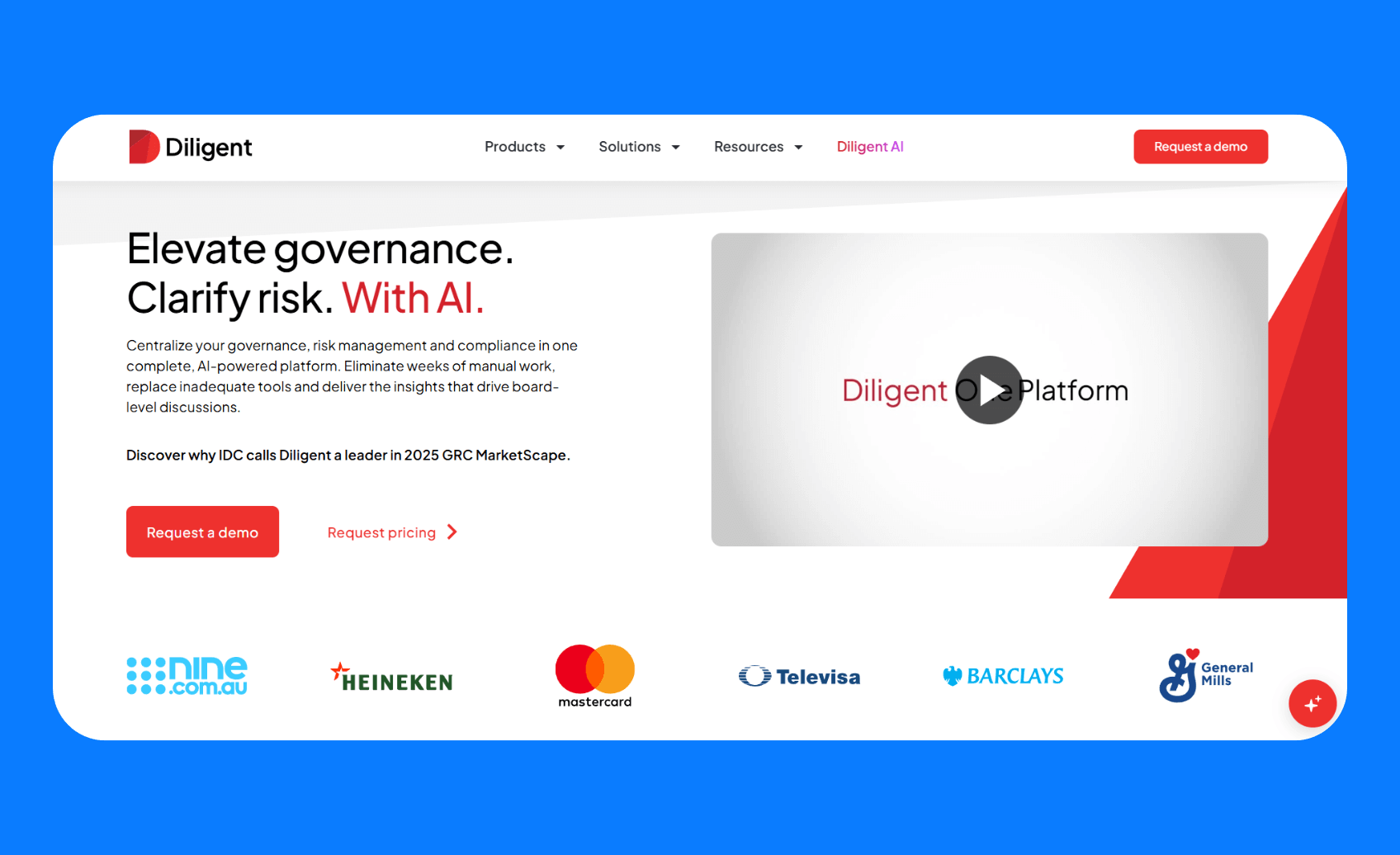
What it does: Diligent is an enterprise risk platform with a AI Risk Essentials module that scans over 180,000 risk disclosures (like SEC 10-K filings) and benchmarks your organization’s risks against industry peers.
Who it's for: Board members and executive teams who need to present unified risk pictures to regulators and stakeholders.
Diligent's AI Risk Essentials uses NLP to scan over 180,000 risk disclosures from public companies. It suggests AI risks you might be missing based on how similar organizations are reporting them.
That kind of benchmarking is gold during board meetings, especially when you’re trying to justify why a risk matters or why it doesn’t.
Key features
- AI-powered risk benchmarking: Compares your risk profile against industry peer disclosures.
- Unified GRC platform: Combines risk, compliance, audit, and board governance in one system.
- Workflow automation: Assigns risk owners and manages approval processes.
- Executive reporting: Board-ready dashboards and risk summaries.
Pros
- Enterprise-ready with full GRC coverage, not just AI risks.
- Provides AI-driven insights for executives.
- It logs every risk assessment, control test, and update for accountability.
Cons
- Not specialized for ML model monitoring.
Pricing
Pricing is custom. Contact their team for a quote.
Bottom line
Choose Diligent if you need to present a unified picture of risk to your board and regulators.
5. Credo AI
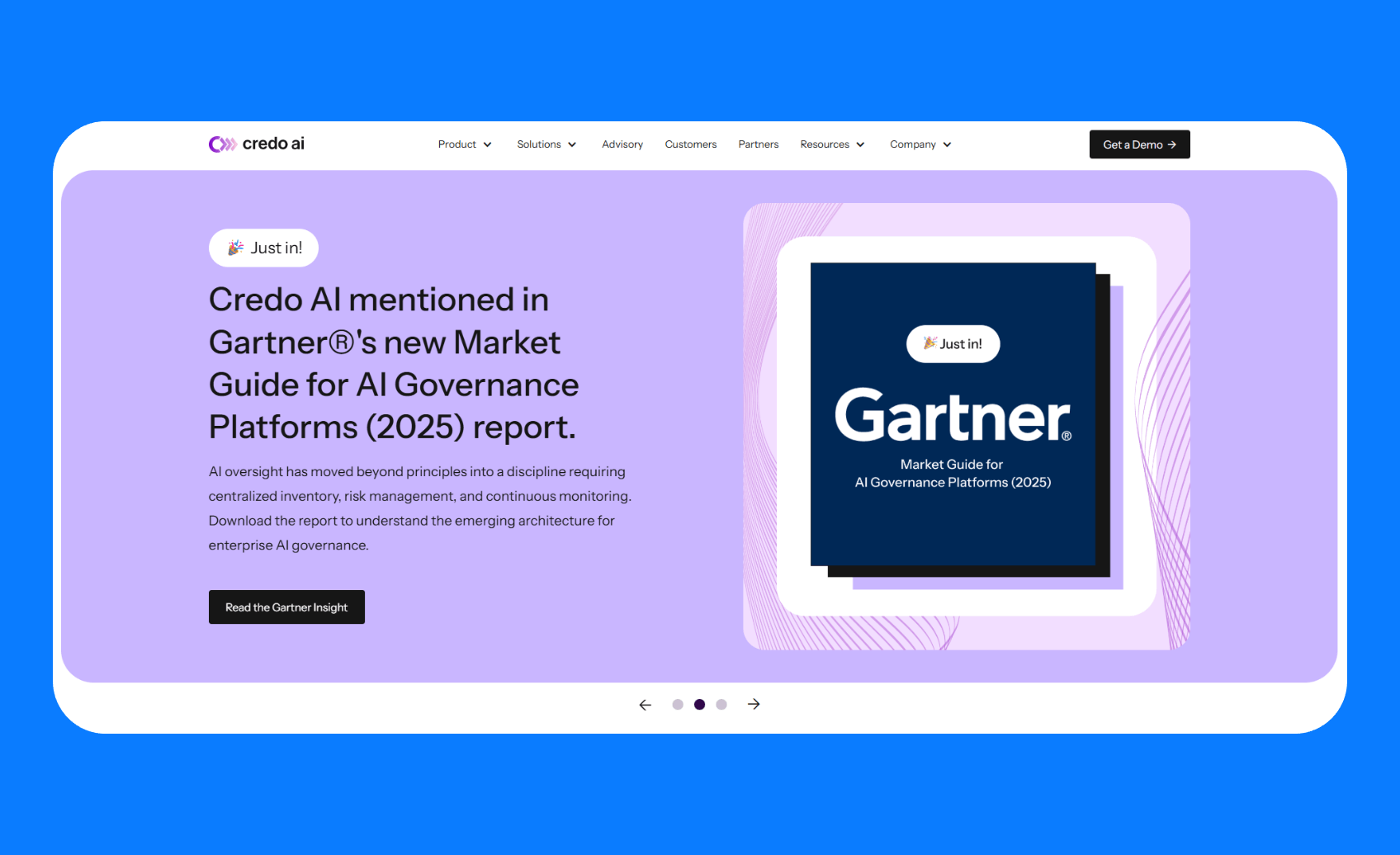
What it does: Credo AI translates ethical and regulatory requirements into actionable workflows for AI projects.
Who it's for: AI governance officers who need to turn responsible AI principles into actual processes, and compliance managers dealing with the growing pile of AI regulations.
Credo AI makes sure that before and during deployment, you’ve checked all the boxes (fairness, transparency, accountability, etc.) and can prove it with documentation.
The Policy packs, which are pre-built sets of requirements for common regulations, are particularly useful. Instead of figuring out what the EU AI Act means for your chatbot, you just apply the EU AI Act policy pack, and Credo AI tells you which requirements are applicable and your compliance status for each.
Key features
- Centralized AI inventory: Credo provides a single repository for all AI systems, models, and even third-party AI vendors in use.
- Policy packs and assessments: Pre-built templates for regulations like the EU AI Act or the NIST AI RMF, plus the ability to create custom policies.
- Risk and impact assessments: Guided workflows that help you think through potential problems.
Pros
- Can handle multiple facets of GRC, which means AI risk lives in the same system as all your other enterprise risks.
- Provides AI-driven insights for executives.
- Every risk assessment, control test, and update is logged.
Cons
- Doesn't include production monitoring. You'll need other tools for that.
Pricing
Pricing is custom.
Bottom line
Choose Credo AI if you do significant internal AI development or rely on third-party AI and need to meet regulatory requirements like the EU AI Act, NIST, ISO, or industry-specific AI guidelines.
6. Fiddler AI

What it does: Fiddler gives you a live window into how your models are performing by tracking drift, bias, and explainability in real time.
Who it's for: ML engineers, MLOps teams, and risk managers who need continuous model oversight.
Once you deploy a model, results can (and often do) go sideways. Data shifts and predictions can be inaccurate.
Fiddler exists to catch those shifts as they happen. It monitors your models in real-time and alerts you when something's off, whether that's accuracy dropping, bias creeping in, or your data starting to look nothing like what you trained on.
It integrates nicely with popular MLOps stacks too including SageMaker, Databricks, or your own homegrown deployment setup. Just drop in the SDK or use the REST API, and you’re monitoring everything from one dashboard.
Key features
- Real-time monitoring: Tracks accuracy, fairness, and drift without you having to remember to check.
- Human-readable model explanations: Breaks down model decisions in terms your business team can actually understand.
- Works with your existing stack: Integrates with popular ML platforms and custom setups.
Pros
- Catches problems early instead of after they've caused damage.
- Has connectors for the most popular ML platforms.
- Can run in your cloud or theirs, depending on your security preferences.
Cons
- Setup requires integrating with your existing models, which isn’t exactly plug-and-play for non-technical teams.
- The interface can be overwhelming if you're new to ML monitoring.
Pricing
Fiddler’s pricing is quote-based. They have tiers like Lite, Business, and Premium, but you must contact them for pricing on each.
Bottom line
If you’ve already got models in production and need to monitor them, consider Fiddler.
7. LogicManager
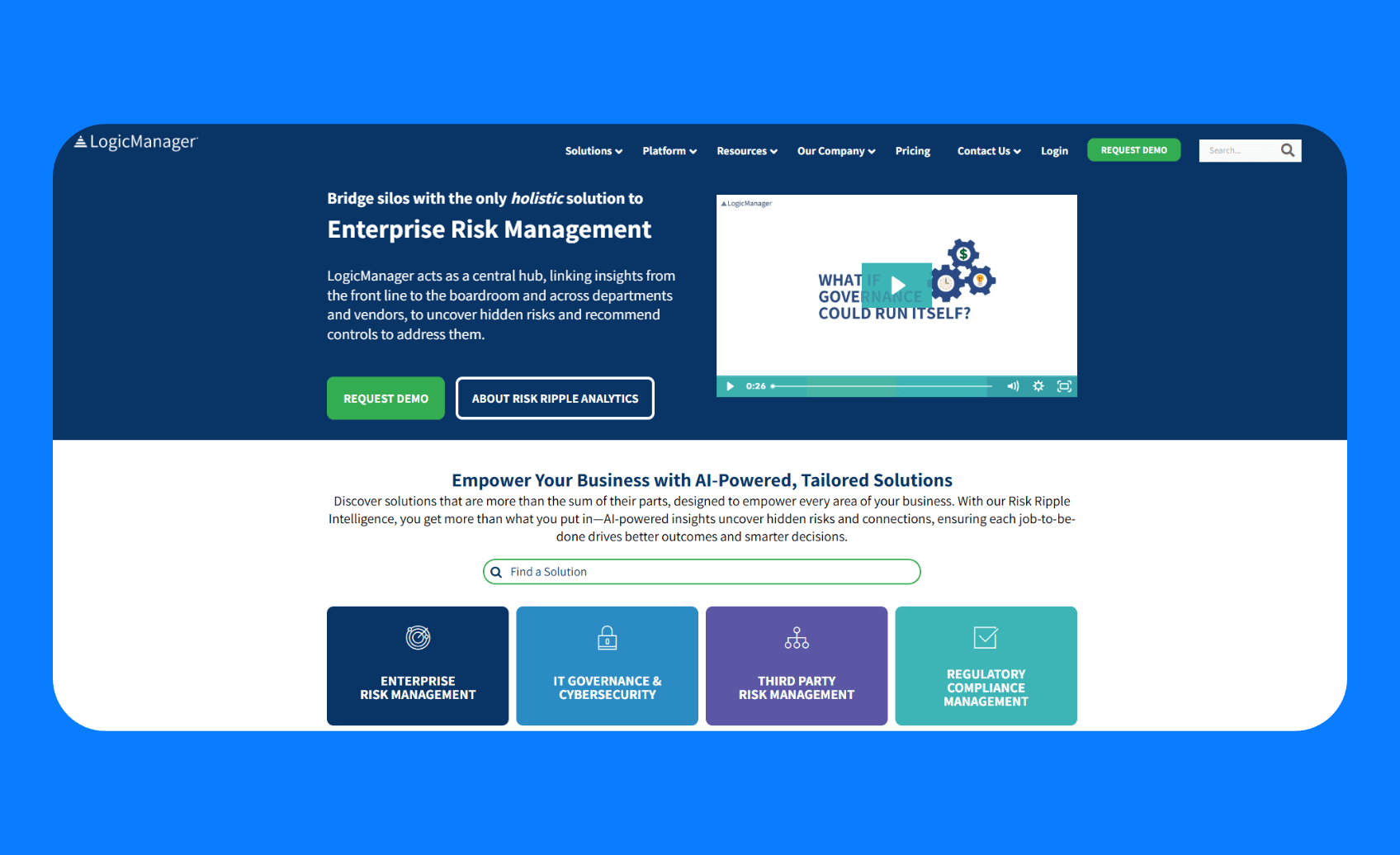
What it does: LogicManager offers modules for various risk domains like operational, financial, compliance, and IT, but you can configure it to include AI or algorithmic risks within those domains.
Who it's for: Risk officers who want to manage AI risks without completely rebuilding their entire risk management approach.
I included LogicManager in this list specifically because AI risks are still just risks. You need to track them, assign them to owners, link them to controls, and manage them alongside all your other enterprise risks. LogicManager does this.
You can create AI risk categories (like "AI system gives bad advice to customers" or "Model shows bias in hiring decisions") and treat them like any other business risk. Assign owners, link them to mitigation controls, and set up review cycles.
The flexibility here is solid. You can customize fields, adjust scoring criteria, and set up workflows without waiting for vendor support.
Key features
- Structural risk registers: You maintain a structured list of risks, categorized by business area or process. LogicManager provides taxonomies you can use.
- Custom scoring and scoring: Create scoring criteria that actually match your AI use cases, and run periodic reviews.
- Incident linking: If an AI incident occurs, log it as an incident in LogicManager, link it back to the risk entry, and document how you resolved it.
Pros
- Integrates AI risks into your existing enterprise risk framework.
- Let's you tailor workflows, dashboards, and reporting templates to your specific needs.
- Centralized visibility makes it easier to demonstrate and monitor risk mitigation efforts.
Cons
- Doesn’t monitor models or detect bias, so you’ll still need tools like Fiddler for that.
- The UI feels a bit clunky, and bulk updates can be tedious.
Pricing
LogicManager’s pricing is subscription-based and tiered. They have different solutions to choose from, including enterprise risk management and third-party risk management. Pricing is custom, and you pay for the solutions you need.
Bottom line
Use LogicManager if you want to manage AI risks like the business risks they are, without creating a completely separate risk management process.
8. Arthur AI

What it does: Arthur AI provides model monitoring for teams that need to track their AI but don't have enterprise budgets or dedicated MLOps teams.
Who's it for: Small to mid-sized teams and startups that need model monitoring but don’t have a huge budget or dedicated MLOps team.
Arthur monitors your traditional ML models for drift and bias, and can even evaluate your LLMs using ground truth data or human feedback.
The platform is fully hosted, so you don't need to provision servers or become a DevOps expert. You can start with their free tier to get a feel for how it works, then upgrade when you need more sophisticated alerting or custom metrics.
They also maintain an open-source evaluation library (Arthur Evals) for custom LLM testing, which is useful if you're building with large language models and want to make sure they're not gradually producing bad outputs.
Key features
- Drift detection: Uses statistical checks to alert you when incoming data no longer resembles your training set.
- Bias monitoring: Tracks performance across defined sensitive groups and raises alerts when the model crosses thresholds.
- Explainability: Offers both global feature importance and prediction-level insights.
- LLM and agent evaluation: Built-in tools to score and improve generative outputs.
Pros
- Free tier and $60/mo plan make it a no-brainer for smaller teams.
- Fully hosted, so you don’t need to provision servers or deal with on-prem installs.
- Support ML models, Gen AI, and agentic AI.
Cons
- Focused on observability rather than policy enforcement.
Pricing
Arthur AI is refreshingly transparent in pricing for its standard plans. You can start free for core model performance metrics, then pay $60/month when you need custom metrics or alerting integrations.
Bottom line
Arthur is my recommendation for teams that want to track how their models are performing but are early in their maturity or operating with smaller budgets.
9. IBM Watson OpenScale
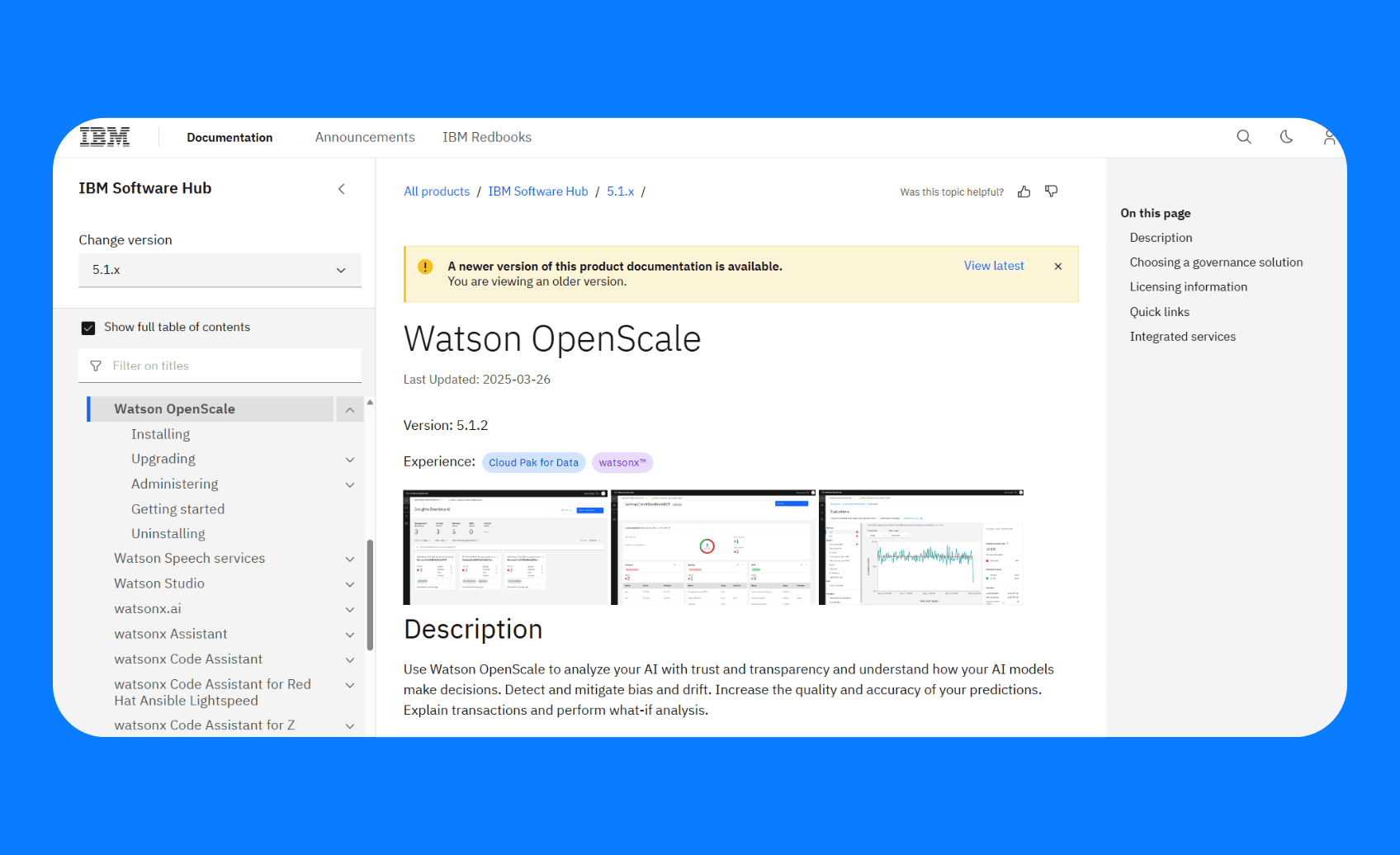
What it does: IBM Watson OpenScale continuously tracks model performance, detects issues like bias or drift, explains model decisions, and even suggests corrective action.
Who's it for: Large organizations (Fortune 500s, financial institutions, etc.) that are deeply invested in AI and often already users of IBM Cloud, Watson, or Cloud Pak for Data.
OpenScale is IBM’s answer to Responsible AI at scale. It offers a centralized platform for monitoring, explainability, and fairness, with the kind of governance features that appeal to compliance-heavy industries like finance, insurance, and government.
It’s often compared with tools like Fiddler or Arthur, but the differentiator is its deep integration in an enterprise stack and IBM’s stamp of approval (which matters to some execs).
Key features
- Bias and drift detection: Built-in metrics from IBM’s AIF360 toolkit help track fairness and detect performance degradation.
- Multi-modal explainability: Works with structured data, text, and neural network models.
- Auto-generated mitigation suggestions: When OpenScale flags issues, it can also recommend corrective actions.
- Enterprise-grade controls: Includes audit logging, access management, and policy enforcement across environments.
Pros
- Built-in IBM’s Fairness algorithms, like their AIF360 metrics.
- Native support for IBM Cloud and Cloud Pak for Data.
- Covers a wide range of model types, including deep learning and NLP.
Cons
- Configuration and deployment are complex, especially if you’re not using IBM services.
- Licensing and pricing models are often opaque and tied to broader IBM contracts.
Pricing
Watson OpenScale’s Standard v2 plan charges users on a per-model basis. You won’t run into limits on payload size, feedback data, or the number of explanations you generate. However, there are quota caps on specific resources like service providers and subscriptions. It can get complicated. Most likely, you’ll engage IBM for a custom deal.
Bottom line
Watson OpenScale is mostly beneficial if you already have IBM; otherwise, you’re bringing a big IBM solution into a non-IBM environment, which is overkill.
10. Monitaur
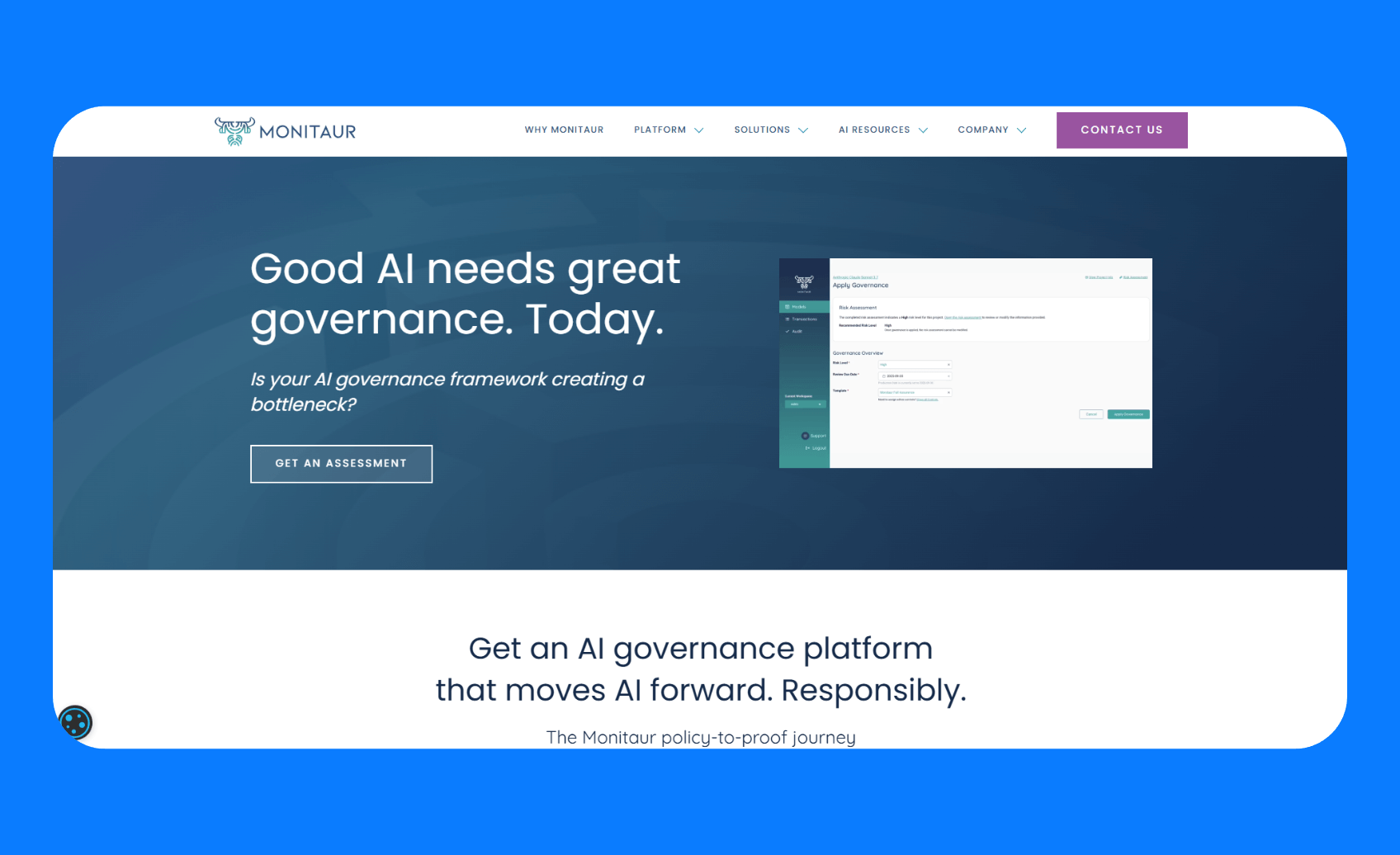
What it does: Monitaur helps organizations prove that their AI systems are operating correctly and fairly by providing transparent records and tools to validate models.
Who's it for: Highly regulated industries like insurance, finance, healthcare, and government that require audit trails for all the decisions AI makes.
Monitaur creates an actual system of record (think black box flight recorder) for AI decisions. It logs what the model did, why it did it, and who signed off on it. It’s not packed with hands-on ML tuning tools like some of the other platforms on this list, but that’s the point. It’s focused on accountability and traceability.
Key features
- Regulatory compliance: Helps teams stay aligned with new AI laws by offering tools for documentation, collaboration, and compliance reporting.
- Vendor and third-party risk: Assess and validate third-party AI services before they become your liability.
- Model risk management: Provides frameworks for documenting, assessing, and reviewing models so you can manage AI risk consistently across your portfolio.
Pros
- Creates a clear record of every model decision, approval, and change.
- Brings engineers, compliance officers, and policy teams together in one system.
- Includes workflows for vendor oversight and regulatory reporting.
Cons
- If you don’t already have some governance processes, there’s a bit of work to define how you want to use Monitaur.
- It doesn’t cover upstream development tasks like model training or data prep.
Pricing
Monitaur’s pricing is custom and not publicly listed.
Bottom line
Monitaur is built for teams that need to prove they’re using AI responsibly.
How I tested these AI risk management tools
To evaluate these tools, I defined key criteria of capabilities to check that focused on drift and bias metrics, governance features, and ease of use. I then spent hands-on time with each platform via demos, free trials, or reading case studies and reviews.
What I looked for:
- Model monitoring and explainability: How well each tool spots drift, bias, or errors, and whether it explains model decisions in a way teams can understand.
- Governance and compliance: How reliably it tracks model history, audit trails, and policy updates.
- Ease of use and integration: How quickly teams can get started and connect the tool to their existing data or MLOps stack.
My testing process: I tested setup, reporting, and automation in each tool. Where I couldn’t get access to the tool, I reviewed customer feedback, documentation, and demos to confirm capabilities.
Additional factors I considered:
- Does it have SSO, RBAC, encryption, and on-premise options?
- Does it scale when you go from monitoring 5 models to 50?
Which AI risk management tool should you choose?
Each platform excels in different areas, so figure out what's actually keeping you up at night before you start shopping.
Here are some guidelines:
- Choose Superblocks if you want to empower everyone in the org to build with AI but want to maintain governance from the start.
- Choose CalypsoAI if you're worried about employees accidentally sharing company secrets with genAI tools.
- Choose Fiddler if you’re running enterprise models in production and need deep insights into drift, bias, and fairness.
- Choose Arthur if you’re a smaller team or have an early-stage project and need an accessible model monitoring solution without enterprise overhead.
- Choose Monitaur, Holistic AI, or Credo AI if you operate in a regulated industry and need detailed audit trails or policy documentation to stay compliant.
- Skip all of these if you don't have active AI deployments yet.
My final verdict
After all the hands-on testing and analysis, my personal recommendation for responsibly building enterprise tools with AI is Superblocks. It strikes the right balance between the convenience of AI development and the security control enterprise environments need.
That said, context matters. If models are failing silently, grab a monitoring tool like Fiddler for visibility.
Build secure governed tools with Superblocks
If you’re ready to take control of your organization’s AI adoption, Superblocks is a great place to start. It will give you immediate guardrails and oversight as teams begin to integrate AI into applications.
I’ve touched on the features that enable this, but just to recap:
- Flexible ways to build: Teams can use Clark to generate apps from natural language prompts, design visually with the drag-and-drop editor, or extend in full code in your preferred IDE. Superblocks automatically syncs updates between code and the visual editor, so everything stays in sync no matter how you build.
- Built-in AI guardrails: Every app generated with Clark follows your organization’s data security, permission, and compliance standards. This addresses the major LLM risks of ungoverned shadow AI app generation.
- Centralized governance layer: Get full visibility and control with RBAC, SSO, and detailed audit logs, all managed from a single pane of glass. It also connects to your existing secret managers for secure credentials handling.
- Keep data on-prem: Deploy the Superblocks on-prem agent within your VPC to keep sensitive data in-network and maintain complete control over where it lives and runs.
- Extensive integrations: Connect to any API, data source, or database, plus all the tools in your software development lifecycle from Git workflows to CI/CD pipelines, so your apps fit naturally into your existing stack.
Ready to build secure and scalable internal apps? Book a demo with one of our product experts.
Frequently asked questions
What is the best AI risk management tool for enterprises?
Superblocks is the best AI risk management tool because it combines fast AI deployment with centralized control. Your developers and semi-technical staff can spin up internal applications quickly, but with guardrails like RBAC, audit logs, and SSO.
How much do AI risk management platforms typically cost?
AI risk management platforms range from affordable options like Arthur AI’s $60/month starter plan to custom enterprise solutions. Larger platforms such as IBM Watson OpenScale are priced individually, often as part of broader IBM contracts.
What's the difference between AI governance and AI risk management?
AI governance establishes policies, processes, and controls for responsible AI development, while AI risk management focuses on identifying, monitoring, and mitigating specific risks from AI systems.
Can AI do risk management?
Yes, AI can assist with risk management by automating risk detection, analysis, and monitoring processes.
Which framework is most commonly used to manage risks in AI projects?
The NIST AI Risk Management Framework (AI RMF 1.0) is the most commonly used framework for managing risks in AI projects, especially in the United States. Other frameworks include ISO/IEC 23053 for AI risk management and IEEE standards for ethical AI design.
Stay tuned for updates
Get the latest Superblocks news and internal tooling market insights.
You've successfully signed up
Request early access
Step 1 of 2
Request early access
Step 2 of 2
You’ve been added to the waitlist!
Book a demo to skip the waitlist
Thank you for your interest!
A member of our team will be in touch soon to schedule a demo.
Table of Contents




